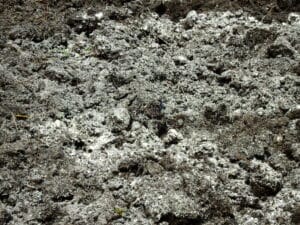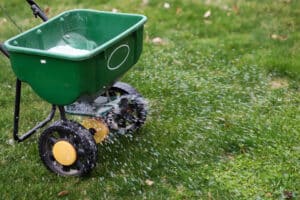Fertilizing a lawn can be a daunting process. Between selecting fertilizer, finding the right application time, and determining how much fertilizer to apply, it’s a lot of work. That’s why professional lawn care services can save you time and stress.
The best lawn care providers know how to establish a fertilization schedule that will maintain your lawn’s health by applying the appropriate mix of nutrients at the right time. This can help promote stronger root systems and greener grass, even during harsh weather.
If you’re serious about having a lush, healthy lawn, the right fertilizer is essential. Here’s how you can find the best fertilizer service for your lawn.
Find Lawn Help
- See our list of top lawn care companies based on in-depth research.
- Select the company that best meets your needs.
- Get a free, no-obligation quote for your home.
Get a Quote From Lawn Professionals Near You
Compare quotes from local pros

Lime Soil Amendment

Lawn Fertilization
What Are the Different Types of Lawn Fertilizers?
Lawns need fertilization because, over time, grass may suck all the nutrients out of the soil. The right type of fertilizer for your lawn can restore it to its green glory. The main nutrients in fertilizer are nitrogen (N), phosphorus (P), and potassium (K).
The NPK value shows the percentages of each nutrient in the fertilizer. For example, a fertilizer with an NPK value of 18-20-10 is 18% nitrogen, 20% phosphorus, and 10% potassium.
Different fertilizers release these nutrients at different rates and have their own benefits and disadvantages. These are the main types of fertilizer.
Quick-Release Fertilizer
Quick-release fertilizer is made up of synthetic materials and shows fast results since it provides plants with nitrogen immediately after application. It can enhance your lawn’s aesthetics very quickly.
However, releasing nutrients into the soil too quickly can leach the soil and harm the environment, and applying too much of this fertilizer can burn your lawn. Unlike other fertilizers, the results only last two to four weeks.
Slow-Release Fertilizer
Slow-release fertilizer can be natural or synthetic. It releases nutrients at a gradual pace, based on the outside temperature and moisture levels. Slow-release fertilizer won’t show immediate results, but the effects will last longer—up to six to eight weeks, or more.
By releasing nutrients slowly and consistently, this fertilizer doesn’t stress your grass. This type of fertilizer is better for the environment than quick-release because it is less likely to leach into the soil.
Organic Fertilizer
Organic fertilizer is composed of organic materials as opposed to synthetics. Microbes and fungi break down the matter, slowly releasing the nutrients into the soil. Common ingredients include compost, bone meal and blood meal, feather meal, fish, kelp, and bat guano.
Organic fertilizers cost more than traditional types, and using them means it takes longer to see results, but the results can last for roughly six weeks. Overall, organic fertilizer is good for soil health, adding structure and improving water flow.
Granular Fertilizer
Granular fertilizers are “dry fertilizers” that come in small pellets. They come in both synthetic and natural forms and are spread on the ground. The pellets must break down before they can release nutrients. In general, granular fertilizers are cheaper than liquid fertilizers.
Liquid Fertilizer
Liquid fertilizers are popular for several reasons. Each drop of the liquid concentrate has exactly the same proportions of nutrients, while granular fertilizer pellets may have more variety. Nutrients can move more easily through liquid fertilizers, so the soil can absorb the nutrients faster. You can apply liquid fertilizer to the ground or directly onto the foliage.
What Are the Different Types of Fertilizer Spreaders?
You can spread your fertilizer using multiple types of tools. These are some of the most common:
- Hand-held spreaders: Best for small lawns, hand-held spreaders are powered by a crank or battery and spread fertilizer while you walk.
- Broadcast/rotary spreaders: These are the most common. As you push a broadcast spreader, it releases the fertilizer in an overlapping pattern across a broad swath of grass. They’re best for medium and large lawns because they allow you to spread a lot of fertilizer in a short amount of time. Pull-behind spreaders are a subset of broadcast spreaders that you pull instead of push.
- Drop spreaders: These spreaders are better for precision, especially if you have tighter turns or sophisticated landscaping. Instead of spreading the fertilizer ahead, drop spreaders drop the fertilizer directly beneath them as you push.
When Should You Fertilize Your Lawn?
Different grass species should be fertilized at different times of year for optimum growth and health. Warm-season grasses, like Bermuda grass, zoysia grass, and St. Augustine grass, should be fertilized in spring when they bounce back from winter dormancy and begin to green again. Cool-season grasses, like fescues, ryegrass, and Kentucky bluegrass, should be fertilized between late summer and fall.
If you don’t know what type of grass you have, this guide can help.
How Often Should You Fertilize Your Lawn?
How often you fertilize your lawn depends on its condition and needs, so always be sure to test your soil to determine what’s best. Although some people recommend fertilizing once a year, we recommend two to four times per year, including fertilizing in the winter, to fix any nutrient deficiencies and maintain a thick, beautiful lawn. Always be sure to follow product directions about the amount and frequency of fertilization to ensure proper results without burning your lawn.
Lawn Fertilizer Service vs. DIY
Now you’ve got a good idea of the types of fertilizers available, how to spread them, and when to spread them. If you’re already overwhelmed, it might be a sign that hiring a professional lawn fertilizer service is the way to go.
Let’s take a look at some pros and cons of hiring a professional lawn fertilizer service versus doing this the DIY way.
Pros and Cons of Fertilizer Services
Pros
- Save time and energy: Hiring a professional service saves you time and effort.
- Diagnostics: A professional can perform a high-quality soil test to diagnose any issues in your lawn and provide the best fertilizing strategy that won’t waste any time with guesswork.
- Avoid confusion: Product labels can be very confusing, breaking down the values of various elements. Professionals know the ins and outs of products and can apply everything correctly.
- Consistent schedule: Professionals can develop the ideal fertilization schedule for your lawn, so you don’t have to puzzle over the best time of year, weather, or growing conditions.
- Professional-grade products and equipment: Professionals have access to tools and fertilizers you may not be able to get as a homeowner.
- Guarantee and better results: If you tackle this on your own, you risk getting poor results. Professionals do this for a living and have the experience to fertilize the right way every time. Many service providers even offer guarantees to ensure your satisfaction.
Cons
- More expensive: Even though DIY means purchasing products and tools, it often comes out cheaper than hiring a professional service.
- Risk of hiring wrong person: If you don’t do your research, you might end up with a company that doesn’t deliver what it promises.
Pros and Cons of DIY Fertilizers
Pros
- Budget-friendly: Doing it yourself is less costly than hiring a professional, so if your budget is your top priority, DIY is your best option.
- Health and exercise: Fertilizing can be good for fitness since you do the labor yourself. Want to do some curls with the fertilizer bag? Go for it.
- Time outdoors: Often, we don’t take enough advantage of the sunshine. Fertilizing is a good excuse to get outside and get your hands dirty.
Cons
- Investment in equipment and products: Even though the DIY approach may be cheaper, you may end up spending money on equipment and products that you use so rarely that it’s not worth it.
- Time and effort investment: Fertilizing takes time and energy you could spend on something else.
- Risk of poor results: Without experience, you could see poor results—or worse, over-fertilize and hurt your lawn’s health.
How Much Does Lawn Fertilizer Cost?
It’s up to you to decide if you want to do it yourself or hire professionals. We know budget is a big factor. Here’s a rough estimate of some of the costs you could expect.
Lawn Fertilizer Service Pricing
The amount you pay for your lawn fertilizer service will depend on a few factors, including where you live, the type of treatment you choose—organic tends to be more expensive—and the size of your lawn.
According to Homewyse.com, the average cost of a lawn fertilizer service in Raleigh, N.C., would be $0.10 per square foot on the low end, and $0.29 on the high end. So fertilizer service for a 1,000-square-foot lawn could cost you anywhere from $100 to $290 per application. That’s the total cost, including the labor, products, and job supplies.
- LawnLove.com estimates that professional lawn fertilization costs between $103 and $343 per visit.
DIY Fertilizer Pricing
DIY fertilizing might be more challenging to calculate because there are many different brands and types of fertilizers, and you can’t simply buy a bag of fertilizer that will be the exact amount you need for your lawn.
According to Costowl.com, a bag of quality fertilizer could set you back $6 to $26 depending on the pounds per bag and type of nutrients included, a walk-behind broadcast spreader could cost anywhere from $100 to $300, and a hand spreader goes for $10 to $75.
In the end, DIY always shakes out as more budget-friendly, but that doesn’t necessarily mean it’s more cost-effective. If you do a bad job or don’t get the results you want, that’s money down the drain.
Professional Fertilizer Service Recommendation: TruGreen
Here’s an overview of our recommended provider, TruGreen, and its lawn care plans:
| Plans | TruHealth℠ Lawn Care Plan | TruComplete℠ Lawn Care Plan | TruSignature℠ Lawn Care Plan |
|---|---|---|---|
| Fertilization | ✓ | ✓ | ✓ |
| Lime Soil Amendment | ✓ | ✓ | ✓ |
| Pre-Emergent and Targeted Weed Control | ✓ | ✓ | ✓ |
| Aeration | – | ✓ | ✓ |
| Overseeding | – | ✓ | ✓ |
| Tree and Shrub Services | – | – | ✓ |
Our Conclusion
Achieving a beautiful green lawn requires some hard work. Not only that, but it may require some expertise. Hiring a professional lawn fertilizer service can save you time and energy and avoid the potential headache of using the wrong fertilizer.
FAQs About Using Lawn Fertilizer
What is 10-10-10 fertilizer good for?
10-10-10 is an all-purpose fertilizer that can be used on almost any type of outdoor plant, so it’s good for any plant that doesn’t need one of the three macronutrients in differing amounts.
Does TruGreen do fertilizer?
TruGreen specializes in lawn care plans that include fertilization services to help strengthen your grass. Their experts will formulate a program to address your specific lawn deficiencies.
Is it cheaper to fertilize your own lawn?
While a DIY approach may be cheaper up front, that doesn’t necessarily mean it’s more cost-effective. If you don’t get the results you want, that’s money down the drain.





